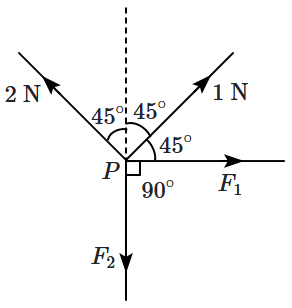Select Question Set:
The distance covered by a body of mass \(5\) g having linear momentum \(0.3\) kg-m/s in \(5\) s is:
1. \(300\) m
2. \(30\) m
3. \(3\) m
4. \(0.3\) m
Subtopic: Newton's Laws |
71%
Level 2: 60%+
NEET - 2022
Hints
A mass is thrown vertically upward. The direction of the net force acting on the mass during its upward and downward journey, respectively, is:
| 1. | upward, upward | 2. | upward, downward |
| 3. | downward, upward | 4. | downward, downward |
Subtopic: Types of Forces |
70%
Level 2: 60%+
Please attempt this question first.
Hints
Please attempt this question first.
The velocity \((v)\)-time \((t)\) graph of a lift moving upwards has been shown below. Let \(T_1,\) \(T_2\) and \(T_3\) be the tensions in elevator cable during the time intervals \(\Delta t_1\), \(\Delta t_2\) and \(\Delta t_3\). Then \(T_1: T_2: T_3\) is:
(take \(g=10\) m/s2)

1. \(12:10:11\)
2. \(11:10:9\)
3. \(11:10:8\)
4. \(12:10:12\)
(take \(g=10\) m/s2)

1. \(12:10:11\)
2. \(11:10:9\)
3. \(11:10:8\)
4. \(12:10:12\)
Subtopic: Tension & Normal Reaction |
69%
Level 2: 60%+
Please attempt this question first.
Hints
Please attempt this question first.
In the diagram shown, the normal reaction force between \(2\) kg and \(1\) kg blocks is:
(Consider the surface to be smooth and \(g=10\) ms–2 )

(Consider the surface to be smooth and \(g=10\) ms–2 )

| 1. | \(25\) N | 2. | \(39\) N |
| 3. | \(6\) N | 4. | \(10\) N |
Subtopic: Tension & Normal Reaction |
55%
Level 3: 35%-60%
NEET - 2022
Hints
Unlock IMPORTANT QUESTION
This question was bookmarked by 5 NEET 2025 toppers during their NEETprep journey. Get Target Batch to see this question.
✨ Perfect for quick revision & accuracy boost
Buy Target Batch
Access all premium questions instantly
Given below are two statements:
| Statement I: | When a railway engine pulls a train and the system moves forward, the force exerted by the engine on the train is greater than that exerted by the train on the engine. |
| Statement II: | The normal force exerted by the ground on a man is the reaction force of the weight of the man. |
| 1. | Statement I is incorrect and Statement II is correct. |
| 2. | Both Statement I and Statement II are correct. |
| 3. | Both Statement I and Statement II are incorrect. |
| 4. | Statement I is correct and Statement II is incorrect. |
Subtopic: Application of Laws |
Level 4: Below 35%
Hints
Four forces are acting at a point \(P\) in equilibrium as shown in the figure. If the ratio of force \(F_1\) to \(F_2\) is \(1:x,\) then the value of \(x \) is:


| 1. | \(4\) | 2. | \(3\) |
| 3. | \(2\) | 4. | \(1\) |
Subtopic: Application of Laws |
68%
Level 2: 60%+
Please attempt this question first.
Hints
Please attempt this question first.
A block is placed on a smooth horizontal surface, and forces are applied to it as shown in the diagram. Take \(g=10~\text{m/s}^2.\) The normal reaction acting on the block is:

1. \(100~\text N\)
2. \(60~\text N\)
3. \(40~\text N\)
4. \(20~\text N\)

1. \(100~\text N\)
2. \(60~\text N\)
3. \(40~\text N\)
4. \(20~\text N\)
Subtopic: Tension & Normal Reaction |
71%
Level 2: 60%+
Hints
The system of blocks is pulled up by force as shown in the figure. The force exerted on the \(3\) kg block by the connecting string is:


| 1. | \(80~\text{N}\) | 2. | \(60~\text{N}\) |
| 3. | \(40~\text{N}\) | 4. | \(100~\text{N}\) |
Subtopic: Application of Laws |
70%
Level 2: 60%+
Hints
The friction force on \(2~\text{kg}\) block is:

1. \( \dfrac{15\sqrt{3}}{2} ~\text N\)
2. \(7 \sqrt{3}~\text N\)
3. \(10~\text N\)
4. none of these

1. \( \dfrac{15\sqrt{3}}{2} ~\text N\)
2. \(7 \sqrt{3}~\text N\)
3. \(10~\text N\)
4. none of these
Subtopic: Friction |
55%
Level 3: 35%-60%
Please attempt this question first.
Hints
Please attempt this question first.
Given below are two statements:
| Assertion (A): | Improper banking of roads causes wear and tear of tyres. |
| Reason (R): | The necessary centripetal force in that event is provided by the force of friction between the tyres and the road. |
| 1. | Both (A) and (R) are True and (R) is the correct explanation of (A). |
| 2. | Both (A) and (R) are True but (R) is not the correct explanation of (A). |
| 3. | (A) is True but (R) is False. |
| 4. | Both (A) and (R) are False. |
Subtopic: Banking of Roads |
70%
Level 2: 60%+
Hints
Select Question Set:






